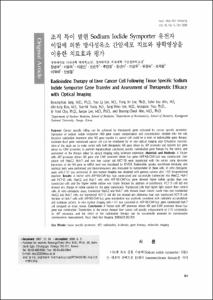KUMEL Repository
1. Journal Papers (연구논문)
1. School of Medicine (의과대학)
Dept. of Internal Medicine (내과학)
조직 특이 발현 Sodium Iodide Symporter 유전자 이입에 의한 방사성옥소 간암세포 치료와 광학영상을 이용한 치료효과 평가
- Keimyung Author(s)
- Jang, Byoung Kuk
- Department
- Dept. of Internal Medicine (내과학)
- Journal Title
- 핵의학분자영상
- Issued Date
- 2008
- Volume
- 42
- Issue
- 5
- Abstract
- Purpose: This study is to evaluate rib fractures on bone scan in breast cancer patients treated with breast cancer surgery and radiation therapy and to evaluate its relation with radiation therapy and operation modality. Materials and Methods: Two hundred seventy cases that underwent serial bone scan after breast cancer surgery and radiation therapy were enrolled. Bone scan and chest CT findings of rib fracture were analyzed. Results: The rib uptake was seen in 74 of 270 cases (27.4%) on bone scan and 50 cases (18.5%) were confirmed to have rib fracture by chest CT. The rate of modified radical mastectomy in patients with rib fracture was significantly higher than that in patients without rib fracture (66.0% vs. 27.0%, p=0.000). The rate of additional radiation therapy to axillar or supraclavicular regions in patients with rib fracture was significantly higher than that in patients without rib fracture (62.0% vs. 28.6%, p=0.000). Rib fracture was seen most frequently at 1-2 years after radiation therapy (51.9%) and single rib fracture was seen most frequently (55.2%). Of total 106 rib fractures, focal rib uptake was seen in 94 ribs (88.7%) and diffuse rib uptake was seen in 12 ribs (11.3%). On one year follow-up bone scan, complete resolution of rib uptake was seen in 15 ribs (14.2%). On chest CT, the rate of fracture line in ribs with intense uptake was significantly higher than that in ribs with mild or moderate uptake (p=0.000). The rate of presence of fracture line in ribs with focal uptake was significantly higher than that in ribs with diffuse uptake (p=0.001). Conclusion: Rib fracture in breast cancer patients after radiation therapy was related to radiation portal and operation modality. It should be interpreted carefully as a differential diagnosis of bone metastasis.
목적: 본 연구는 유방암절제술 후 방사선 치료를 받은 환자에서 발생한 늑골골절의 골스캔 소견을 분석하고 방사선 치료와의 상관관계를 알아보고자 하였다. 대상 및 방법: 유방암으로 수술 후 방사선 치료를 받고 추적 골스캔을 시행받은 270예를 대상으로 골스캔을 분석하였다. 골스캔에서 늑골의 섭취증가가 관찰 된 경우 흉부CT를 통해 늑골골절을 확인하였다. 늑골골절은 각 예의 총 방사선 조사량, 방사선 치료범위, 방사선 치료 당시 연령, 수술술식, 방사선 치료 후 늑골골절이 나타난 기간, 늑골골절의 개수, 위치, 골스캔에서의 섭취증가 정도, 유형과 변화양상을 분석하였다. 결과: 방사선 치료 후 추적관찰 중 시행된 골스캔 검사에서 방사선 치료를 시행한 쪽의 늑골에 비정상적인 섭취증가를 보인 예는 총 270예 중 74예(27.4%)였으며, 이 중 흉부CT에서 늑골골절로 확인된 예는 50예(18.5%)였다. 늑골골절이 발생한 군이 그렇지 않은 군에 비해 변형유방전절제술을 시행한 경우가 유의하게 높았고(66.0% vs. 27.0%, p=0.000), 늑골골절이 발생한 군이 그렇지 않은 군에 비해 액와림프절이나 쇄골상림프절 부위에 추가로 방사선치료를 한 경우가 유의하게 높았다(62.0% vs. 28.6%, p=0.000). 늑골골절이 발생한 50예 중 총 106개의 늑골골절이 확인되었고, 단일 늑골골절이 24예(48.0%)에서 발생해 가장 많았다. 방사선 치료 후 골스캔에서 늑골골절이 나타나기까지의 기간은 1년에서 2년 사이가 55개(51.9%)로 가장 많았다. 섭취증가의 유형은 국소형(88.7%)이 확산형(11.3%)보다 많이 나타났고, 1년 후 추적 골스캔에서 섭취증가 정도의 변화는 완전히 사라진 것이 15개(14.2%)였다. 골스캔의 소견과 흉부CT를 비교하여 늑골의 섭취증가가 강할수록 흉부CT에서 늑골의 골절선이 더 많이 보이는 것으로 나타났으며(p=0.000), 섭취증가가 국소형일 때가 확산형일 때 보다 늑골의 골절선이 유의하게 많이 나타났다(p=0.001). 결론: 유방암절제술 후 방사선치료를 시행한 환자의 골스캔에서 섭취 증가로 나타난 동측 늑골골절은 수술술식 및 방사선 치료 범위와 관련이 있으며, 방사선치료 후 1-2 년 사이에 가장 빈번하게 나타나며, 국소형으로 주로 한 개의 늑골에서 보인다. 이러한 소견들은 골스캔으로 유방암 환자의 골전이를 평가할 때 도움이 될 것으로 생각된다.
- Alternative Title
- Radioiodine Therapy of Liver Cancer Cell Following Tissue Specific Sodium Iodide Symporter Gene Transfer and Assessment of Therapeutic Efficacy with Optical Imaging
- Keimyung Author(s)(Kor)
- 장병국
- Publisher
- School of Medicine
- Citation
- 장병국 et al. (2008). 조직 특이 발현 Sodium Iodide Symporter 유전자 이입에 의한 방사성옥소 간암세포 치료와 광학영상을 이용한 치료효과 평가. 핵의학분자영상, 42(5), 383–393.
- Type
- Article
- ISSN
- 1975-129X
- Appears in Collections:
- 1. School of Medicine (의과대학) > Dept. of Internal Medicine (내과학)
- 파일 목록
-
-
Download
 oak-bbb-05326.pdf
기타 데이터 / 2.5 MB / Adobe PDF
oak-bbb-05326.pdf
기타 데이터 / 2.5 MB / Adobe PDF
-
Items in Repository are protected by copyright, with all rights reserved, unless otherwise indicated.